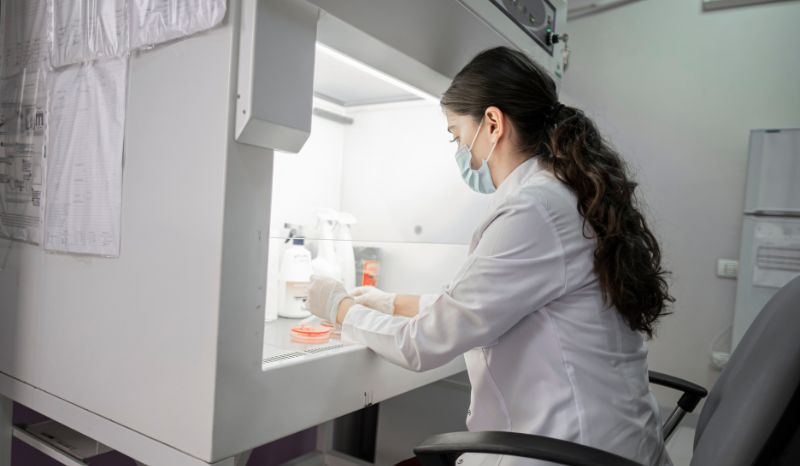Lab coats represent more than their functional role since they function both as protective equipment and professional apparel. The lab coat performs its key protective functions in addition to serving hygiene purposes in all scientific settings, including research labs, hospitals, and chemistry courses. The lab coat maintains crucial functions, which turn it into an essential piece of clothing for science settings and medical facilities regardless of its basic design.
This article investigates multiple lab coat applications, such as proper usage scenarios and regulations for donning a coat, together with consequences from improper use and the traditional white color choice.
When Should You Wear Your Lab Coat?
Experts agree that wearing a lab coat becomes mandatory when exposure to dangerous chemicals, biological materials, or hazardous substances remains possible. The clothing standard exists to protect workers within science labs, medical laboratories, research facilities, and manufacturing facilities. Staff who need to handle risky materials during work must wear a lab coat as a protective measure.
Students who participate in university chemistry laboratory experiments must follow the mandatory requirement of wearing lab coats. Medical staff and diagnostic personnel use lab coats in hospitals as well as diagnostic labs to preserve sterility while blocking cross-infectious exposure. Through their effective role in hygiene maintenance and quality control measures, lab coats serve important purposes in the pharmaceutical and food industries.
Protect yourself and your workwear – Shop Now for Lab Coats and stay safe in every lab setting.
What Happens When You Don’t Wear a Lab Coat?
Individuals who work in laboratories should always use lab coats because failure to do so creates serious safety hazards. Your clothing and skin become vulnerable to hazardous substances consisting of corrosive chemicals along with infectious agents and flammable materials once the protective barrier is eliminated. A single small spillage could result in burns along with stains and the risk of lasting injuries.
The decision to go without a lab coat will create problems for both your individual safety and the protection of your workspace. Outside world substances, which include dust and pollen or pet hair, tend to pollute experiments, particularly in sensitive setups, including microbiology and pharmacological laboratories. The practice of cross-contamination poses a severe threat because materials from different experiments can accidentally transfer between surfaces, which generates both unreliable data and possible safety hazards.
Your lack of professional compliance by failing to wear a laboratory uniform during necessary circumstances might damage your expert standing due to perceived negligence or carelessness in scientific or healthcare fields.
Why are Lab Coats White?
Scientists and medical professionals rely on the white lab coat as their essential standard of working attire. Traditional associations regard white color as representing professionalism, cleanliness, and trust. White lab coats highlight all stains and contaminants because these visual markings indicate when it is time for laundry or a new item purchase. Hygiene demands particular attention in clinical areas and laboratories due to its critical significance.
Medicine moved away from quackery at the beginning of the 19th century, leading medical practitioners to select white as their official attire. The shift from black to white lab coats started when doctors wanted to show their commitment to medical purity and scientific strictness, which scientists then adopted to create a professional work environment.
Today, white lab coats remain the worldwide symbol that identifies medical professionals due to their historic dominance, though additional color options exist.
Do Lab Coat Colors Mean Anything?

Lab coat color provides clues about things beyond what someone simply prefers. White maintains its position as the traditional lab coat color, while organizations use additional colors to represent different roles and departmental positions.
- Medical personnel in surgery and laboratory technicians wear blue or green lab coats to distinguish themselves from doctors.
- Senior staff members, along with pharmacists and modern academic settings, adopt black lab coats for either aesthetic value or prestige reasons.
- Hospital staff working in zones where hazards exist may use disposable lab coats in different colors to define safe zones and classification of contamination.
The professional white lab coat remains the primary standard of cleanliness, yet selected colored versions serve to improve identification in lab roles and allow individual expression.
What is the Main Purpose of a Laboratory Coat?
The primary role of a laboratory coat—or lab coat—is protection. A laboratory coat places an essential barrier in front of dangerous materials that could enter your body. From accidental spills to splashes of corrosive chemicals or infectious samples, the lab coat shields your clothing and skin from exposure.
So besides safeguarding workers, the lab coat serves multiple useful functions:
- When conducting sensitive laboratory work, contamination prevention requires wearing a new, clean lab coat to block outside pollutants from causing disturbances.
- A professional appearance produces a consistent uniformity across different departments leading to higher credibility.
- A lab coat serves as an emergency tool because it provides instant removal capability in situations such as chemical spills or fires for quick harm reduction.
- Work tools and pens, together with instruments and notepads, can be kept in the extensive pockets found on most lab coats.
The lab coat uses category effectively prevents microorganisms from spreading because it works in environments that require complete cleanliness, such as microbiology laboratories and medical diagnostic spaces.
Laboratory safety protocols strongly depend on the laboratory coat as a critical safety instrument.
Conclusion
A basic laboratory garment serves as an essential tool for protecting both safety and hygiene standards as well as professional conduct in scientific and medical facilities. Working either in laboratories or healthcare facilities demands the essential use of lab coats as they protect people from dangerous spills and keep work settings contamination-free. The white lab coat maintains its symbolic worth because it signifies trust together with knowledge and care while also representing various industry sectors.
Ready to gear up? Order your lab coat here and stay protected in every experiment or task.
Need bulk orders or specific sizing? Request a quote and our team will get back to you promptly with the best options tailored to your needs.




